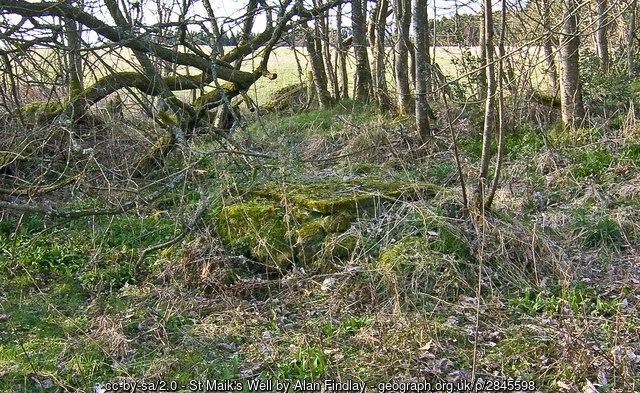 |
Dedication: Saint Mayota Location: Drumoak Coordinates: 57.07785N, -2.30811W Grid reference: NO814985 Status: capped Heritage designation: none |
HOME - SCOTLAND - ABERDEENSHIRE
 |
Dedication: Saint Mayota Location: Drumoak Coordinates: 57.07785N, -2.30811W Grid reference: NO814985 Status: capped Heritage designation: none |
St Mayota, who is also called Mayok and Mazota, is said to have been a daughter of St Donald, and the eldest of the so-called "Nine Maidens" who travelled to Scotland with St Bride to teach Garnard, the son of the King of the Picts, about Christianity. According to some sources, these "Nine Maidens" lived in the Glen of Ogilvy, in the parish of Glamis, which was, at the time, infested with geese, who were consuming crops and causing havoc; according to the story, Mayota forbade the geese from returning to the parish, and they were never seen again. This miracle was described in Bellenden's Chroniklis of Scotland:
|
His eldest douchter, Mayot, maid inhibitation to the wild geis, to eit hir faderis corne, and thay obeyit hir haly monitionis; and thairfore, wild geis was nevir sene efter on that ground. |
The parish of Drumoak itself has always, it appears, had an association with St Mayota, and it can be assumed that she visited the area at some point during her time in Scotland. The earliest version of the parish's name was mentioned in a papal bull of Pope Adrian IV, from 1157, as "Ecclesiam de Dulmayok". By the 15th century, however, the name had changed, likely through corruption, to its modern form: in 1407, a charter that was granted by a Bishop Gilbert mentions "Alexr. de Kynloch prebendarius de Drumoak". It is very likely that St Maik's Well existed at the same time as the church, so it very probably dates from at least 1157.
Regardless of the well's possible age, the earliest reference to the site that I have been able to find dates from 1792, and appears in the third volume of The Statistical Account of Scotland, as part of a section that focuses on Drumoak and which was written by a Mr. James Fraser
|
In this part of the country, it is almoſt always called Dalmaik. The church and manſe are ſituated by the river Dee, on a haugh (in Erſe Dal); and near, a well, which has ſtill the name of St Maik's Well. |
Apart from this reference, very little attention has been payed to the site at all. It was seldom mentioned during the 19th century; when it was, most authors simply copied exactly what Fraser had already written. As a result, practically nothing is known of its history, apart from the fact that it supplied water to the nearby manse during the 1960s, and that its water was probably used for baptisms.
Today, the well still survives, although it appears to have been capped and its water is certainly not used for baptisms any longer.
|
Access: The well is located on private land. |
Copyright 2025 britishholywells.co.uk